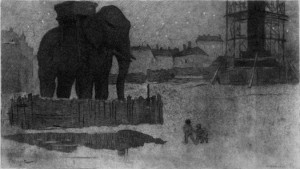Gavroche and the Adventure of the Incognito Family

I thought I had remembered all of the Thénardier children. Éponine, of course. Azelma, who doesn’t appear in the musical but doesn’t really have much of a role in the book anyway. And finally (I thought), Gavroche, the lovable street urchin who’s treated as an orphan in the show but is a runaway (who occasionally goes back to visit) in the book.
There are actually two younger brothers, whom Hugo doesn’t name, making five in all. Mme Thénardier only has enough love for her daughters. Not Cosette, not her sons, not anyone else in the world.
Now get this: Remember Magnon, Gillenormand’s ex-servant who gets him to pay for her two children by claiming they’re his? Her children die in an epidemic of croup, and the Thénardiers agree to let her have their small boys so that she’ll keep getting her stipend. M. Gillenormand doesn’t notice when he visits, whether because he’s not paying attention or because he’s just old.
“In Paris to change the street in which one lives is to change one’s identity.”
But here’s the thing: The arrangement is basically the same one Fantine thought she was getting into with Cosette…but the Thénardiers get Magnon to pay them for the privilege of raising their children. On the plus side, she actually treats them quite well, a lot better than their biological parents would have.
Until she gets arrested in a sweep following the Gorbeau arrests.
Orphan Family Reunion
They come home from playing, and everyone’s gone. The two of them wander the streets until a happy-go-lucky street urchin with a Robin Hood streak decides to take them under his wing: Yes, Gavroche, who doesn’t even know they’re his own brothers.
“Bread must be as rigorously protected as gold” – Especially in this book.
Gavroche takes him to his nest in a wooden elephant statue that was originally built as a model for a monument that was scrapped in favor of (IIRC) the Arc de Triomphe. As Hugo puts it, the “useless” structure, decaying and ugly, found a greater purpose than the monument would have: it became the home for a child.
On arrival, he does his best to put them at ease, and shows them the blankets and the net he’s set up to keep the rats away. They’re not sure what a rat is, but he explains it’s a kind of mouse, which doesn’t sound so bad…
‘Why don’t you keep a cat?’
‘I had one,’ said Gavroche. ‘I brought one in, but they ate it.’ This reply entirely undid the soothing effect of the previous one.
Later on we learn that Gavroche never saw them again after that night, and never learned who they were.
Prison Break
Montparnasse tries, but unlike Javert, he is not a master of disguise.
“The so-called New Building, which was in a state of lamentable decrepitude…” The word “new” always does seem to outlive its accuracy, doesn’t it? Part of the gang breaks out from there, climbing up through the chimney and running along the rain-slick roofs to freedom.
Thénardier is in solitary and under constant supervision, so they figure it can’t hurt for him to have an iron spike to keep his food away from the rats. Except one guard who thought maybe a wooden spike would be better, but everyone ignored him. Typical.
Hugo makes use of his this-really-happened conceit to get out of explaining Thénardier’s “impossible” escape, saying that no one’s ever figured it out, even though he could have glossed over the details without calling attention to it. “Escape by either of these two routes was virtually impossible.” As a virtual impossibility, it must have been a finite improbability, therefore we need merely calculate how improbable his escape is, plug that figure into the finite improbability drive, and… what was I saying? Ah, yes. Clearly, his escape was a quantum phenomenon, and he used both escape routes
Montparnasse makes it “a point of pride to understand all the slangs and speak none of them.” Sort of like Han Solo and foreign languages? This is also the point where Hugo makes the “unofficial son-in-law” comment that hints at something between him and Éponine.
Anyway, Thénardier makes it to the top of a wall but can’t climb down it, so the gang needs to send someone small up with a rope, and they recruit Gavroche, who takes one disdainful look at the wall as if to say “that’s it?” and zooms up effortlessly – even if it is his father that he’s rescuing. “Well, no matter.”
Thénardier’s first words on reaching the street: “Well, so now who are we going to eat?” Charming, to the last. He’s ready to check out that Rue Plumet house he heard about, and doesn’t even notice the little boy who brought him the rope and has been waiting around as if hoping to hear something.
Don’t you know your own kid? Apparently not.
For the most part, Gavroche doesn’t seem to care about his family, and vice versa. But he protects his brothers instinctively, and here you get a sense, just for a moment, that he really does want some sort of…love, acceptance, something from his parents, but he can’t show it.
It’s a poignant moment for a character who goes through most of the book as the plucky comic relief, one of very few glimpses behind the constant smile.
I’m about 150 pages ahead in my reading, and just finished Part Four of five last night. Almost to page 1000! It’s been a long slog, slower than I would have liked, but I’m determined to finish both the book and my commentary before the end of the year.
Pages covered: 812-843. Image by Jeanniot from an unidentified edition of Les Misérables, via the Pont-au-Change illustration gallery.